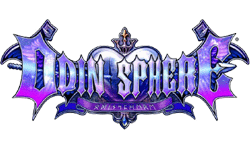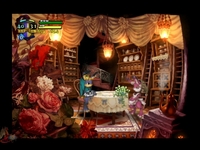|
|

|
BATTLE SYSTEM
|

|
INTERACTION
|

|
ORIGINALITY
|

|
STORY
|

|
MUSIC & SOUND
|

|
VISUALS
|

|
CHALLENGE
|
Setting
|
COMPLETION TIME
|
40-50 hours
|
|
OVERALL
4.5/5
|
Rating definitions
|
|
|
Odin Sphere has garnered a lot of attention so far. Most games are announced well in advance and take time to finally reach the store shelves. Odin Sphere has done exactly the opposite, with its original announcement only a few months ago, and the difference from release in Japan to release in North America only a mere five days. All of these things don't give the fans time to cool off from their original excitement.
Odin Sphere isn't about a particular person, but about the end of the world. Five main storylines are played out to explain how this shall occur. Each storyline puts together another piece of the puzzle to create one brilliantly entwined story. The storylines are played one at a time, and in a specific order. The items and money of each individual character stay with that character. Only the knowledge the character gains from scrolls found on their journey is shared across the storylines. There is much interaction between the main characters, helping to form a complete timeline. All the previously viewed scenes can be revisited at any time and are displayed in order of the overall timeline, providing a complete view of the world, eventually.
Because the player will be going over the same block of time over and over again, they will have to do the same areas and bosses over and over again as well. This gets a bit tiring the fourth or fifth time through, but each main character has a different weapon, or Psypher, which gives each player its own advantages and disadvantages on the various monsters and bosses. While some of the characters get to fight a unique boss here and there, a lot more variety would have been welcome.
Battle areas consist of a connecting network of completely circular zones. The current character will fight one to three different kinds of monsters per level, based on the difficulty. Every level has a difficulty rating of one to five stars. Without the map, each new zone is a mystery until you enter and complete it. If it's too much to handle, you can select Retry from the menu, which sends you back to the previous zone with the same items and levels you left it with. Dying in the game is very forgiving. The level resets and you simply get to try it again with all your used items returned.
 Action packed
Action packed
|
|
Items are rewarded based on how well the battle area was cleared. The score is an equation of time and damage; the less of both, the better the score, and better the prizes. Every area has an item that will be given no matter what the score. This item is shown on the map view, so planning which areas to tackle before others can ease the strain on the item collection. The majority of the items that will be found are seeds. When a monster dies, it releases Phozons, which are the essence of life. If a seed is planted, the Phozons are drawn to the seed, allowing it to use that energy to grow. Once the plant has received enough Phozons, it will bear fruit in most cases, which the player knocks off the plant and consumes for HP and experience points. Eating is the only way to gain experience points in Odin Sphere. The weapon, or Psypher, also needs power to grow. By holding down R1, the weapon will draw in any stray Phozons and use that for its own experience points. The weapon and the wielder will have separate levels, and both need to be raised to be victorious in battle.
Items are stored in multiple bags. All the characters start with two bags that can each hold eight items. During their adventures, other bags are available for sale. At first they can only buy small bags holding one or three items, but eventually the bags that hold eight items become available. However, since each character can only have six bags in use, any smaller bags that have been purchased will have to be emptied and sold back for a loss once the bigger bags become available. It's a tricky balance of inventory versus wasted spending.
The Alchemy system is a main reason for item collection. Material, the base ingredient, is used to create all the potions the player will need. All the items in the game have a mix value when added to the Material. Most of the seeds add one point to the material. Various foods will add three or five points to a material. Mixing two Materials will multiply the number of both into a single mixture. During the game, various Alchemy recipes will be located and added to the general knowledge for all characters. Only once a recipe is found can the item be made, so there's no point in digging up all the recipes on the internet in hopes of getting a jumpstart on the game. The only number that matters for the type of potion is the ones digit. A Material of 18, 28, and 48 will all make the same potion when mixed with the correct catalyst. The larger the number, the more Phozons will be released back into the air after the mixture is completed. These can then be used for an easy Psypher boost, or to grow some much needed food.
 The way to a man's heart is through his stomach
The way to a man's heart is through his stomach
|
|
Overall, the item system is easy to use, but time consuming. The multiple bags can be seen all at once with the R2 button, but items can't be selected from it. Typically the item wanted is located using this view, then paging through the various bags until it's found. All time is paused while in the item menu, so the game is forgiving in that manner. It would have been nice to be able to select an item directly while viewing all the bags, but at least it can be used to sort the items quickly into the various bags so they can be found easier later on.
The pride and joy of the title has to be the graphics. With the use of high quality sprites on top of vibrant, multi-leveled backgrounds, the eye candy enthusiasts will want for nothing. The battle motions are fluid and easy to use, and controls nearly flawless. The only complaint would be pushing the system a little too far, as a very few areas may suffer from slowdown from overloading the system. It's the price to pay when churning out so much with so little, and since it happens so rarely, the overall visual quality is worth the minor imperfection.
The music, which was also highly praised by Atlus, is indeed a pleasure to the ear. However, there's simply not enough of it. Most of the time spent in the battle areas are covered with only a few selections of music. A lot more variety could have been used in each of the sections of the world, instead of the same music, especially after an area is cleared, where time is spent mixing potions or waiting for food to grow. Another option would have been for each character to have his or her personal musical score for the battle areas. So much of the music is used for the story instead. A little more balance would have been nice, especially since the areas are repeated by each character.
Odin Sphere's time to release didn't give fans a chance to catch their breath, and the game doesn't either. It's a fast-paced action RPG that brings with it a full-blown story from multiple angles. Despite the minor nitpicks here and there, the game is sheer joy to play. Each character pulls you into their side of the story, forming the collective knowledge that only the player can fathom. It's exciting to see each piece of the puzzle fall into place, and questions answered from earlier storylines. Odin Sphere is a game that's easy to get into and hard to put down.
Review Archives
|









